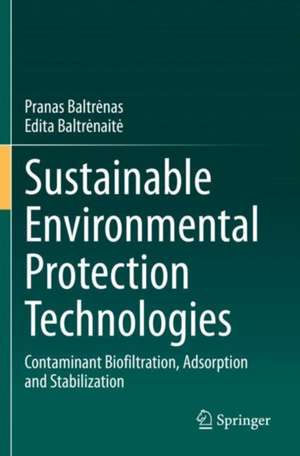Sustainable Environmental Protection Technologies: Contaminant Biofiltration, Adsorption and Stabilization
Autor Pranas Baltrėnas, Edita Baltrėnaitėen Limba Engleză Paperback – 9 iul 2021
| Toate formatele și edițiile | Preț | Express |
|---|---|---|
| Paperback (1) | 590.46 lei 38-44 zile | |
| Springer International Publishing – 9 iul 2021 | 590.46 lei 38-44 zile | |
| Hardback (1) | 612.09 lei 38-44 zile | |
| Springer International Publishing – 9 iul 2020 | 612.09 lei 38-44 zile |
Preț: 590.46 lei
Preț vechi: 738.07 lei
-20% Nou
Puncte Express: 886
Preț estimativ în valută:
113.02€ • 122.81$ • 94.100£
113.02€ • 122.81$ • 94.100£
Carte tipărită la comandă
Livrare economică 17-23 aprilie
Preluare comenzi: 021 569.72.76
Specificații
ISBN-13: 9783030477271
ISBN-10: 3030477274
Pagini: 645
Ilustrații: XXI, 645 p. 287 illus., 123 illus. in color.
Dimensiuni: 155 x 235 mm
Ediția:1st ed. 2020
Editura: Springer International Publishing
Colecția Springer
Locul publicării:Cham, Switzerland
ISBN-10: 3030477274
Pagini: 645
Ilustrații: XXI, 645 p. 287 illus., 123 illus. in color.
Dimensiuni: 155 x 235 mm
Ediția:1st ed. 2020
Editura: Springer International Publishing
Colecția Springer
Locul publicării:Cham, Switzerland
Cuprins
Chapter 1.- The importance of technogenesis and sustainable environmental protection technologies. Chapter 2.- Natural and artificial biogeochemical barriers as natural technologies. Chapter 3.- The sustainable natural materials and their role in waste management and soil contamination stabilizing. Chapter 4.- The sustainable natural materials used for adsorbing contaminants from aqueous medium. Chapter 5.- Biotechnologies as the sustainable environmental protection technologies. Chapter 6.- The major properties of natural materials used in biofiltration systems. Chapter 7.- Operational parameters of biofiltration systems required for efficient operation of components ensuring system’s sustainability. Chapter 8.- Natural and inoculated microorganisms as important component for sustainability of biofiltration system. Chapter 9.- The technologies of the sustainable environmental protection in real conditions in the case of biofiltration systems.
Notă biografică
Prof. Dr. Habil Pranas Baltrėnas is the Chief Researcher of the Research Institute of Environmental Protection at Vilnius Gediminas Technical University (VGTU). He was the founder and formerly the Director of the Research Institute of Environmental Protection, as well as the founder and Head of the Department of Environmental Protection from 1993 to 2013. Additionally, he is the Editor-in-Chief of the VGTU Journal of Environmental Engineering and Landscape Management, and is a member of several more environmental engineering and environmental protection boards and associations. He is the author and co-author of 660 publications, including 18 monographs, 3 textbooks, 26 analytical and review methodical works, as well as 345 research papers, including 60 papers published abroad and 100 certificates and patents.
Prof. Dr. Edita Baltrėnaitė is a Professor in the Department of Environmental Protection at Vilnius Gediminas Technical University (VGTU) in Lithuania. She is also the Executive Editor of the Journal of Environmental Engineering and Landscape Management, a member of the VGTU doctoral committee for Environmental Engineering. Since 2007, Edita has been a scientific secretary of the international Journal of Environmental Engineering and Ecological Science, a member of the Editorial Board of the Journal published by Romanian Academy of Science, Annals – Series on Chemistry Sciences, a member of EISN-Institute and NJF. On 27 January 2017, Prof. Dr Edita Baltrėnaitė was appointed to the Agricultural and Biological Science Editorial Advisory Group at Cambridge Scholars Publishing. Her research interests include the application of biogeochemical processes to environmental protection technologies, the evaluation of transportation of potentially toxic elements in the ecosphere, and the application of lignocellulosic products in environmental protection engineering. She is the author of 92 papers, 1 textbook and 3 book chapters.
Prof. Dr. Edita Baltrėnaitė is a Professor in the Department of Environmental Protection at Vilnius Gediminas Technical University (VGTU) in Lithuania. She is also the Executive Editor of the Journal of Environmental Engineering and Landscape Management, a member of the VGTU doctoral committee for Environmental Engineering. Since 2007, Edita has been a scientific secretary of the international Journal of Environmental Engineering and Ecological Science, a member of the Editorial Board of the Journal published by Romanian Academy of Science, Annals – Series on Chemistry Sciences, a member of EISN-Institute and NJF. On 27 January 2017, Prof. Dr Edita Baltrėnaitė was appointed to the Agricultural and Biological Science Editorial Advisory Group at Cambridge Scholars Publishing. Her research interests include the application of biogeochemical processes to environmental protection technologies, the evaluation of transportation of potentially toxic elements in the ecosphere, and the application of lignocellulosic products in environmental protection engineering. She is the author of 92 papers, 1 textbook and 3 book chapters.
Textul de pe ultima copertă
This book discusses the need for the development of sustainable environmental protection technologies to reduce the impact of environmental contaminants. Three levels of sustainable technologies are addressed. The first level involves the concept of sustainable technologies as natural technologies, or ecotechnologies, whereby contamination level is assessed based on the contamination footprint through the use of biogeochemical barriers (e.g. methods utilizing the bioaccumulation properties of plants). The second level concerns the use of sustainable natural materials, such as biochar, in environmental engineering systems, an approach that is used for analyzing the processes of adsorption and biofiltration, as well as immobilization of contaminants in soil. The third level discusses the optimal components necessary to achieve sustainability in environmental engineering systems, including system operation principles, structural solutions, and the synergies between various system components such as microorganisms. The book will be of interest to specialists of industrial enterprises engaged in environmental protection, as well as environmental system designers, stakeholders from environmental protection ministries and institutions, researchers, doctoral students and masters and bachelors of science in the field of environmental engineering.
Caracteristici
Presents the need for the development of sustainable environmental protection technologies Discusses the components necessary to achieve sustainability in environmental engineering systems Demonstrates how engineering solutions such as biochar and biofiltration can ensure the sustainability of systems
